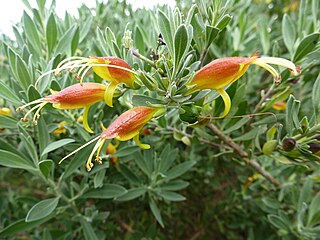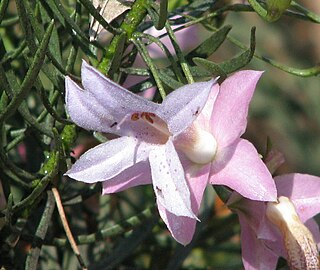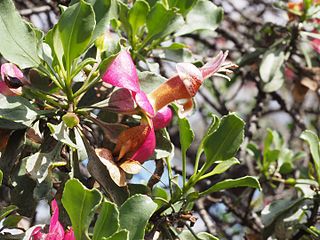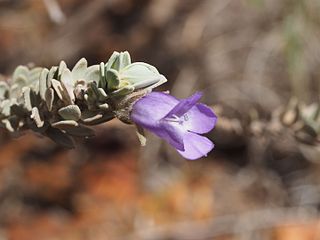
Eremophila glabra, commonly known as tar bush, is a plant in the figwort family, Scrophulariaceae and is endemic to Australia. It is sometimes a low, ground-hugging and sometimes an erect shrub. The leaves are variable in size and shape and there is a range of flower colours. In spite of its scientific name, not all forms of the plant are glabrous but most have many small, raised glands on the stems, flowers and leaves.

Eremophila oldfieldii, commonly known as pixie bush, is a flowering plant in the figwort family, Scrophulariaceae and is endemic to Western Australia. It is a shrub or small tree with rough bark, broad, flat or narrow fleshy leaves and red, orange or yellow flowers.

Eremophila oppositifolia, commonly known as weeooka, twin-leaf emu bush and mountain sandalwood, is a plant in the figwort family, Scrophulariaceae, and is endemic to Australia. It is a shrub or small tree with its leaves arranged in opposite pairs and has cream to red or sometimes maroon coloured flowers. It occurs in all mainland states, but not the Northern Territory.

Eremophila abietina, also known as spotted poverty bush, is a plant in the figwort family, Scrophulariaceae and is endemic to a few arid areas of Western Australia. It is a stiff, upright, compact and very sticky shrub with distinctive, dark bluish-green leaves and pale coloured flowers spotted purple.

Eremophila bowmanii, also known as silver turkeybush, Bowman's poverty bush and flannel bush, is a flowering plant in the figwort family, Scrophulariaceae and is endemic to New South Wales and Queensland in Australia. It is a low to medium, spreading shrub with silvery-grey, hairy foliage and blue to lilac flowers, and sometimes grows in dense thickets with mulga.

Eremophila denticulata, also known as toothed eremophila, toothed poverty bush and Fitzgerald eremophila, is a flowering plant in the figwort family, Scrophulariaceae and is endemic to the south-west of Western Australia. It is an erect shrub with red flowers and leaves that have toothed margins.

Eremophila fraseri, commonly known as burra or jilarnu, is a flowering plant in the figwort family, Scrophulariaceae and is endemic to Western Australia. It is a shrub or small tree with all above-ground parts of the plant, apart from the petals, sticky and shiny due to the presence of a large amount of resin. The petals are coloured white, cream, pink and brown.

Eremophila subfloccosa, also known as dense-felted eremophila is a plant in the figwort family, Scrophulariaceae and is endemic to Australia. It is a shrub which often has foliage covered with soft hairs, giving the plant a silvery grey hue and making it soft to touch. The leaves are strongly scented when crushed. Its flowers are usually greenish yellow in colour and have the stamens protruding from the ends. Dense-felted eremophila is common after fire, but becomes less so as others recover and compete with it.
Eremophila arachnoides is a plant in the figwort family, Scrophulariaceae and is endemic to a few arid areas of Western Australia and South Australia. It is a little-known, broom-shaped shrub with white to mauve, trumpet-shaped flowers which are densely hairy on the inside.
Eremophila compacta, commonly known as compact poverty bush, is a flowering plant in the figwort family, Scrophulariaceae and is endemic to the central west of Western Australia. There are two distinct subspecies differing in their growth habit but both have grey leaves due to a covering of white or grey hairs, and purple to blue, rarely white flowers.

Eremophila phyllopoda is a flowering plant in the figwort family, Scrophulariaceae and is endemic to Western Australia. It is an erect or spreading shrub, sometimes round or flat-topped with sticky, hairy leaves and flowers ranging in colour from pink or lilac to purple.
Eremophila shonae is a flowering plant in the figwort family, Scrophulariaceae and is endemic to Western Australia. It is an erect shrub or a low spreading shrub, depending on subspecies and has very sticky branches and leaves due to the presence of large amounts of resin. The leaves are narrow and the flowers are mauve to purple and white inside with purple spots.
Eremophila simulans is a flowering plant in the figwort family, Scrophulariaceae and is endemic to Western Australia. It is an erect shrub with broad, serrated leaves and violet to purple flowers.

Eremophila spectabilis, commonly known as showy poverty bush, is a flowering plant in the figwort family, Scrophulariaceae and is endemic to Western Australia. It is a dense, erect shrub with narrow, greyish leaves and blue, mauve or purple flowers.

Eremophila glabra subsp. albicans is a plant in the figwort family, Scrophulariaceae and is endemic to Western Australia. It is similar to other shrubs in the species Eremophila glabra but it distinguished from them by its usually grey, felty leaves, dull yellow, orange or red flowers with hairy sepals, growing in sandy soils on dunes and limestone outcrops between Bunbury and Shark Bay.

Eremophila glabra subsp. carnosa is a plant in the family Scrophulariaceae and is endemic to Western Australia. It is similar to other shrubs in the species Eremophila glabra but is distinguished from them mainly by its narrow elliptic to lance-shaped leaves and by the type and arrangement of hairs on its leaves and branches. It is found in coastal areas between Leeman and Gregory.

Eremophila jucunda subsp. jucunda is a plant in the figwort family, Scrophulariaceae and is endemic to Western Australia. It is a small shrub with hairy leaves and white to violet flowers often growing on stony hillsides. It is similar to subspecies pulcherrima but is distinguished from it by its yellow new growth and more southerly distribution.

Eremophila jucunda subsp. pulcherrima is a plant in the figwort family, Scrophulariaceae and is endemic to Western Australia. It is a small shrub with grey, hairy leaves and sepals and blue or mauve flowers often growing in stony places. It is similar to subspecies jucunda but is distinguished from it by its grey new growth and more northerly distribution.

Eremophila pterocarpa subsp. pterocarpa is a plant in the figwort family, Scrophulariaceae and is endemic to Western Australia. It is a common and widespread large shrub or small tree with grey leaves and sepals and orange, pink or yellow petals.

Eremophila pterocarpa subsp. acicularis is a plant in the figwort family, Scrophulariaceae and is endemic to Western Australia. It is a locally common shrub with grey leaves and sepals and a red flower tube which is orange inside.


















